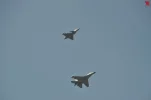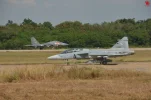“The Swedish air force is now in its Initial Operational Capability phase with the Meteor,” Swedish air force chief Maj. Gen. Mats Helgesson said. “The Meteor missile is the most lethal radar-guided missile in operational service.”
Meteor’s exact specifications are classified, and it being the
best in the world is debatable. But it’s not unreasonable — and that’s because of the missile’s ramjet.
Here’s how it works. A conventional solid-fuel booster accelerates the Meteor after launch, like most air-to-air missiles. But while roaring through the air, the missile opens up a chute, allowing air to rush into the engine, which heats up the oxygen and propels the supersonic missile to Mach 4.
A Meteor missile test flight. Swedish air force capture
Not only that, the missile can adjust
how much oxygen it breathes, conserving energy during the coast phase, only to take a deep breath in the final moments before hitting a target.
The result is that if a targeted plane tries to dodge out of the way, Meteor can overcome it by summoning more thrust, and thus more maneuverability, during those precious few seconds.
Precisely how far the Meteor can go is the big question.
International arms consortiums and governments do not like to openly advertise the specific capabilities of their weapons. That’s especially the case with high-tech ramjets, and all the more because Russia and China are developing their own versions to compete with Meteor.
A Meteor missile attached to a French Rafale fighter. MBDA U.K. Limited photo
We do know that one test off Scotland sent the missile “well in excess of
100 kilometers,” an MBDA engineer told AINonline. The firm has boasted of a “no-escape zone” three times that of the U.S.-made AIM-120 AMRAAM — likewise classified.
The no-escape zone is an aerial combat term for a cone-shaped area — determined by the missile’s capabilities — from where a targeted aircraft cannot escape solely using its own maneuverability. Countermeasures and spoofing is a last resort, but otherwise the aircraft has a high probability of getting toasted.













